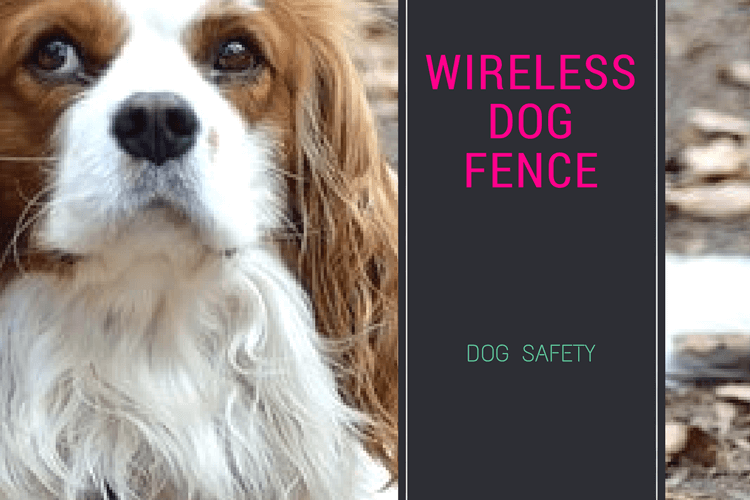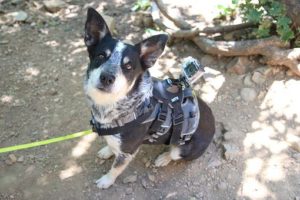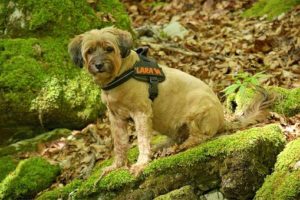We all know the movie scene: a car on the open road, happy music playing in the background, and there, sticking his head out the window – a dog! His ears are flopping in the air as his owner speeds toward their destination. The pup is having so much fun that he probably wouldn’t even mind going to the veterinarian’s office. There is no mention of safety not even a passing remark about how important it is to find the best dog seat belts for your pup!
Reality, however, is not as film-friendly. Sure, it may be fun to let your pooch run loose in the car. In fact, according to AAA, 52 percent of dog owners fessed up to petting their dog while driving, and 4 percent even admitted to playing with their dog while driving! Everyone loves hanging out with man’s best friend. Unfortunately, that explains why 60 percent of dog owners say that they have driven distracted by their pup.

What is the best seatbelt and harness for dogs?
That depends on what you are looking for. Below are reviews of some of the most well-known, best-reviewed dog seat belts on the market. If you want to shop around on your own, consider checking for certifications from the Center for Pet Safety and for confirmation that it has been crash-tested.
URPOWER Upgraded Dog Seat Belt
Vastar 2-Pack Adjustable Pet Car Seat Belt
Ruffwear Load Up Vehicle Restraint
iBuddy Dog Seat Belt
EzyDog Travel Dog Car Harness

Leash Boss Dog Car Seat Belt
Mighty Paw Safety Belt
Kurgo Tru-Fit Crash Tested Dog Harness
Blueberry Pet Seatbelt
Pawaboo Dog Safety Vest Harness with Car Seat Belt Lead Clip
Dangers of petting pets while driving
Even worse, 84 percent of dog owners who drive do not restrain their pooch or do so improperly, which can be just as dangerous. Keep in mind that the two most dangerous places for your dog to ride are in your lap and in the passenger seat. Life is not a movie set, especially not the streets. It is important to know how to properly secure your pup in your car before going for a ride. That way, he can enjoy the breeze coming in through the open windows without you having to worry about him jumping out.
What is a dog car seat belt?
A dog car seat belt is a restraint that keeps your dog safely tethered to the vehicle. Think of it as a really short leash. Its job is to keep your pooch safe and secure in your car. One end connects to the car, and the other connects to your pup’s collar or harness.
Does my dog need a seat belt?
Yes! Just like people, dogs need to be secured before going for a ride. It is possible to protect yourself from the dangers of distracted driving by using a divider to separate the front row from the passenger rows, but that does nothing to defend your dog.
If you have a small pooch, its impact force could be over 300 pounds in a crash, while a bigger pup could reach an impact force of 3,000 pounds. With greater speed and greater size comes greater impact. A car accident like that would most likely be fatal, and if your dog’s body crashes into yours or one of your passenger’s, then it could be deadly for you too. Nobody wants their pup to fly through the windshield or to hit someone else. There are, unfortunately, horror stories about what happens to pooches after a dangerous accident, so it is important to stay safe.
Many people buy dog booster car seats, which are a viable option. However, if you only ever take your pup on short trips to the veterinarian’s office or to the park, then a booster seat may not be worth the cost. A more practical and financially-sound option is a seat belt. Investing in a seat belt/harness/restraint is the same as investing in a static pet containment system like a GPS satellite fence.
Which states require seat belts for dogs?
Does my dog play a role in my car insurance?
Not only can it be against the law to drive without your pooch properly restrained, it can be dangerous for your insurance. Many policies will reject your insurance claim after an accident if it is discovered that your dog was running loose, unrestrained, in the vehicle at the time of the accident, especially if a law is broken. Be sure to talk to your insurance provider if you are concerned.
What about a car harness?
This option is especially good for your furry friend. A seat belt hooked to a dog’s collar focuses all of the impact of the crash onto your pup’s neck. Depending on the severity of the crash, this could strangle your dog or break its neck. If you attach the seat belt to your dog’s harness, just like you would a leash, then the impact of an accident is more evenly dispersed.
Even better, use a harness designed specifically for cars. They fit onto your dog like a vest would, going across their chest. They could also be straps that stretch across the chest. That way, the force of the crash is spread across your pup’s whole body, keeping them safer. The thicker and more padded the straps, the more widely distributed the force of the impact.
Harnesses are especially important for larger dogs. Booster seats tend to be expensive and difficult to find for bigger pooches, crates take up a lot of space, and they can chew through a lot of seat belts. The harness is a great way to help your plumper pups safe. Keep in mind that heavier dogs are more likely to get hurt in a car accident because of the force of the impact.
Are dog seat belts effective?
When used properly, especially with a car harness, dog seat belts are very effective. However, there are certain things to look for that separates a good seat belt from a great one.
For example, consider where the seat belt attaches. One option is to attach to the seat belt and buckle in the car. However, if your pooch has a tendency to step on the seat belt release, then this is a dangerous option. Hyper pups tend to unlatch seat belts themselves, so if your dog is hyper, this is something to consider even if he has never unlatched a belt himself before. Instead, you should probably use a latch bar attachment within the crease of the seat.
Look carefully at the hook and attachment systems. If the restraint is not properly locked to your pooch and your car, then it will not keep him safe. You want to make sure that the attachment is strong and not likely to bend or break. Otherwise, the attachment will buckle or break when there is an accident, throwing your pup forward. The heavier your pooch is, the stronger the hook and attachment system needs to be.
Another factor dependent on size is the length of the seat belt. If it is too loose, then your pooch is not going to be secure and he could be thrown around in an accident. If it is too tight, on the other hand, then it will be uncomfortable and could even choke your dog. One option is an adjustable seat belt, which will allow you to try and find the perfect length for your pup. A second option is a non-adjustable seat belt, in which case you need to measure and weigh your dog before purchasing so that you pick the right size.
Remember that the seat belt is only as good as the person using it. If you hook it up to the front passenger seat, for example, your pup is not going to be any safer because of the air bags. If it connects to the car seat belt buckle instead of to the latch bar, be sure to consider a buckle guard so that your dog cannot unbuckle it himself.

What about crates?
As mentioned earlier, a crate is a good thing to keep in your vehicle in case of an accident so that you can transport your pup to safety afterward. Plus, most laws requiring that your pooch be secured include crates as a proper form of restraint. They also help with motion sickness, making this a great option if your dog has a weak stomach.
The best crates to use are made out of a strong material like aluminum. It is important to make sure that the crate is big enough for your pup to stand, lie down, and turn around. It also needs to be ventilated correctly.
However, in the case of an accident, your dog would be jostled in its crate and, if the door of the crate is not secure, could be thrown out of it. These would result in injuries. It is best, therefore, to use a proper pup seat belt instead of any non-seat belt alternatives.
Are any dog seat belts crash-tested?
There are crash-tested options out there. They tend to include it in the name, so you just have to look for them. It may take a bit of extra searching or cost a little bit more, but you might find that it makes you feel more comfortable.
How do I get my dog used to a seat belt?
If you normally walk your dog with a harness, you will be able to find a seat belt that attaches directly to it, which means the transition will not be difficult for your pup at all.
If your pooch is not already used to a harness, start by walking your dog in the harness that you purchase for his car rides. This will get him comfortable in it, so he is less likely to give you any trouble wearing it in the car.
If you are going to be going on a long car ride, consider having your pup wear the harness around the house from time to time beforehand. Each time, increase how long he wears it so that he gets more comfortable with long-term harness time.
Hopefully, all of this will help guide you through the process of finding the right seat belt for your pup. Now, you should be able to use a seat belt and harness properly. Happy harness hunting, and enjoy your next road trip with your dog!






![12 Best Dog Foods for Toy Breeds [Buyer's Guide] 12 Best Dog Foods for Toy Breeds [Buyer's Guide]](https://shihtzuexpert.com/wp-content/uploads/2019/05/3-5.jpg)
![Best Cheap Dog Foods - our Top 10 Picks of High Quality Brands That Are Still Affordable [Under $1 per pound!] in 2023 Best Cheap Dog Foods - our Top 10 Picks of High Quality Brands That Are Still Affordable [Under $1 per pound!] in 2023](https://shihtzuexpert.com/wp-content/uploads/2018/01/Best-Cheap-Dog-Food-Featured-image.png)








